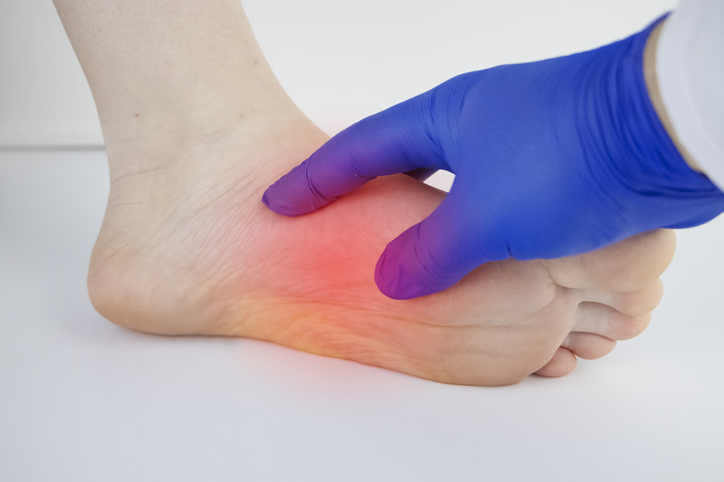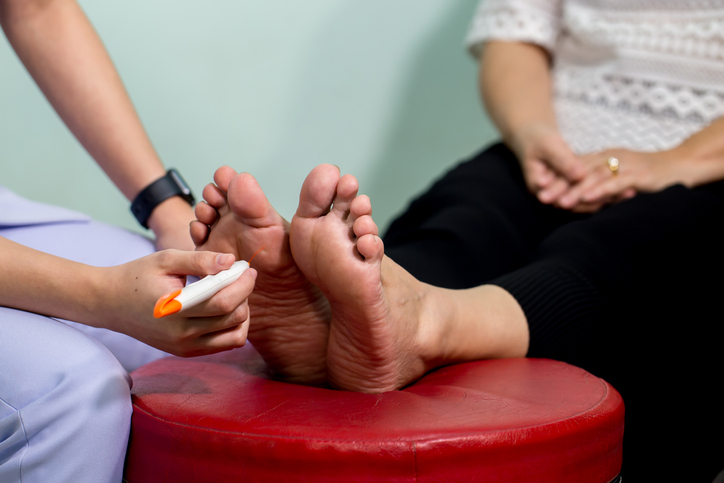Pain
What Is Plantar Fasciitis?

Plantar fasciitis is the most common type of heel pain. The plantar fascia is a thick band of tissue reaching from the heel to the front of the foot; it supports the arch of the foot and acts as a shock absorber. If this tissue gets stretched too far, it causes tiny tears and inflammation that result in heel pain; this is referred to as plantar fasciitis. Heel spurs can also be caused by plantar fasciitis.
Symptoms
Symptoms of plantar fasciitis include, but are not limited to, the following:
- Stabbing pain in the foot when taking the first few steps after waking
- Pain that worsens after standing for an extended period or initially standing after sitting for a prolonged period
- Heel stiffness, which can cause difficulty in everyday activities, such as climbing stairs
- Discomfort that eases a bit with gentle movement (The pain may not be noticeable during exercise or physical activity, but it may develop afterward due to inflammation.)
Diagnostic process
A health care provider can diagnose plantar fasciitis by checking the tender points of the foot. A physician checks the foot reflexes, balance, touch sensitivity, and muscle tone. The location of the pain helps determine the cause. In rare cases, an X-ray or MRI is ordered to diagnose the condition.
Risk factors
Plantar fasciitis is more common in runners, the obese, people who excessively stand on their feet (cashiers, food servers, teachers, etc.), and people who wear shoes without arch support.
Treatment options
If symptoms last for several months without proper treatment, the gait can change, causing damage to the legs, hips, back and knees. Several treatment options are available for plantar fasciitis, including the following:
- At-home care is often sufficient to treat plantar fasciitis. This includes using over-the-counter medications, such as naproxen or ibuprofen, resting the foot, and icing the painful area.
- Physical therapy is prescribed in some cases. Physical therapy involves learning how to stretch the foot and how to use athletic tape to provide support for the foot.
- Water therapy has also been successful in aiding with this condition.
- A splint used during sleep helps to stretch the arch of the foot and calf muscle to relieve pressure. During waking hours, wearing custom-fit arch supports helps distribute weight more evenly across the foot.
- Shock-wave therapy is also an alternative treatment option; the nerve endings in the foot are shocked with mild electrical impulses to ease pain and assist with blood flow.
- Steroid injections can help reduce inflammation.
- An ultrasound-energy procedure is also a possible treatment. During this procedure, ultrasound energy is used to treat the damaged tissue, saving any healthy tissue. This is a quick, minimally invasive procedure, requiring only a small incision to remove scar tissue.
- Surgery may be performed as a last resort to remove the plantar fascia from the heel bone. This procedure is only performed if all other avenues of relief have been unsuccessful in treating the pain.
Plantar fasciitis prevention
To help reduce the risk of plantar fasciitis, wearing high heels, wearing shoes with no arch support, and going barefoot should be avoided. Gently stretching the calf muscle, Achilles tendon, and the plantar fascia on a daily basis is recommended. Wearing shoes with good arch support may also help reduce the risk of plantar fasciitis.







